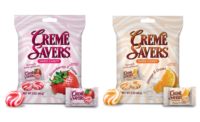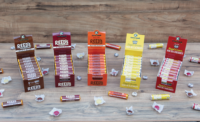
Apple pie a la mode, cotton candy and cinnamon buns – sounds like a concession stand, but in fact it can all be found in a hard candy jar.
Flavors and ingredients are evolving and manufacturers are looking to niche markets as they try to keep up with the future of the candy dish.
Larry Johns, owner and president of Medina, Ohio-based McJak Candy Co., which manufactures Original Gourmet candies, says the hard candy market has remained fairly buoyant.
“I know chocolate has remained strong, but with the current cocoa prices, I think hard candy still has a good niche,” he explains. “It’s a little bit less expensive.”
In fact, data from SymphonyIRI Group, a Chicago-based market research firm, states that unit sales of hard sugar candies have increased 4.49% since a year ago, and manufacturers sold $320.7 million worth of these very traditional treats.
Johns said his company has started mixing flavors, such as apple and cinnamon, to create candies that taste more complex, like a blue-and-pink striped cotton candy lollipop. They also have started adding cream fillings to create flavors like apple pie a la mode, he added. It’s a trend they company started within the last year.
“We kind of took our first guesses as to popularity,” Johns explains. ‘There are certain ones, like cotton candy, that have pink and blue stripes that seem eye catching... that appeal to both adults and kids.”
Meanwhile, Charms Blow Pops now come in flavors like Kiwi Berry Blast and Black Ice. Life Savers, owned by Wrigley, also introduced more complex flavor combinations in 2009 with a Hawaiian Fruits hard candy that included Mango Melon and Tropical Punch.
“Consumers’ pallets are constantly evolving based on culinary trends,” says Jennifer Jackson-Luth, Wrigley senior manager for marketing communications. Johns explains that the possibilities of so many flavor combinations are hard candy’s life blood.
“You can do so many things,” Johns says. “You can buy ones that are more tart and fruity flavors. You can get the cream ones, even cinnamon bun... You can almost find a flavor that anyone would like.”
But all those flavors are useless without the right colors – which not only help market the products, but also convince people to believe what they’re eating. Johns says he learned that lesson first-hand when he once was asked to make clear lollipops touting a company logo for an event, and he flavored them with strawberry.
“They swore up and down they had no flavor. They kept insisting,” he says. “It’s hard to divorce color from flavor in your mind.”
It’s that flavor-color link that has made it hard for companies to move into all natural colors, which are an emerging trend in Europe after artificial colors were linked to hyperactivity there. Johns says that and natural flavors are evolving.
“Natural flavors are a little easier to accomplish,” he says. “The harder problem is coming with a pallet of natural colors that’s as appealing as artificial colors.”
Also, although better-for-you confections, such as candies with vitamins in them, are a growing trend in the overall industry, Johns says the idea hasn’t taken off with hard candies yet.
“There’s some opportunity there provided they don’t change the fl avor of the lollipop,” he says. “Hard candy is something, where when you start eating it, you’re going to be eating it for a half hour, 45 minutes. [You don’t want] any kind of after taste.”
That doesn’t mean healthy isn’t on the hard candy menu though.
Health food sectors and niche markets are driving a lot of innovation right now, Johns said.
However, it can be hard for companies to create products that fit all the various categories.
“Some of the things you develop for one, don’t always translate to the other,” he explains, pointing to the example of using carmine for red color. It’s natural, which appeases those avoiding artificial colors. However, it’s also made from insects, which is not kosher and not accepted at some health food stores.
“It can be a challenge. You want to use as few combinations and please as many markets as possible,” Johns says, adding that ideally one line extension could be sold at all the health food stores. Another challenge for manufactures is finding the ingredients in the first place. Johns points to the difficulty in finding organic corn syrup in large quantities as one example.
“But that’s also where the opportunities are,” he says. “Because if you can overcome some of those things, you’ll be able to find niches others haven’t yet.”
As that happens, the candy dish will no doubt continue to evolve into something your grandma would probably have a hard time recognizing.



